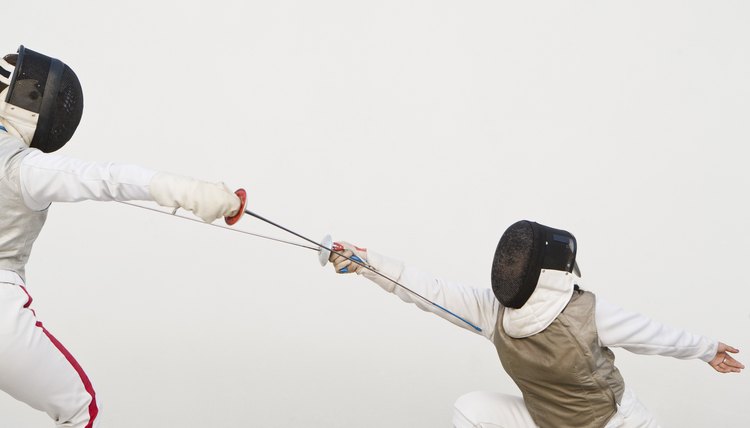The Top 10 Fencing Moves

With its origins dating back to the Middle Ages when fencing masters taught special techniques and "secret thrusts" to their students, modern fencing features moves inspired by the fencing traditions of France, England, Germany, Spain and Italy. Despite the adaptability fencers require during a fencing match, there are actually a limited number of moves that most fencers draw from on the fencing strip. Ranging from basic to complex, these moves cover the majority of situations.
Extension
One of the most basic moves in all of fencing, the extension is also one of the most used. When using weapons that take right-of-way into account, extending the blade allows you to claim right-of-way if your opponent doesn't currently have it. Extensions can be used to score while standing still, during your advance or even while you retreat if your opponent is advancing toward you.
Lunge
Designed as a means of attacking quickly from a distance, the lunge is one of the most well-known fencing moves. Lunging requires more commitment than standard extensions and may leave you open to attack if parried or dodged. The key to a good lunge is a fast strike toward your opponent followed by an equally quick recovery to take you back out of fencing distance.
Riposte
The majority of initial attacks made on the fencing strip are parried, dodged or otherwise unsuccessful. From those attacks that are parried, the defender has a brief opportunity to launch a counterstrike known as a riposte. A proper riposte is performed immediately after the parry without drawing back or disengaging; the goal is to attack directly off of the blade you parried before your opponent has a chance to recover and defend.
Feint Attack
Feints are false attacks designed to provoke your opponent into defending so that you can attack from a different angle. Feints can be performed in several different ways such as rotating your blade under your opponent's blade when he attempts to parry. Once your blade is no longer in danger of being parried, strike at your opponent's target area with a real attack.
Beat Attack
A beat attack is an attack on your opponent's blade, made either with the intention of trying to provoke a reaction from your opponent or to break your opponent's right-of-way. As the name implies, beat attacks are made by striking your opponent's blade with your own with a small sideways motion. Do not overuse beat attacks, as an opponent who anticipates your beat can move his blade out of the way and take advantage of a momentary hole in your defense.
Counterparry
Fencing features a number of parries, though only four of these parries are commonly used. There are alternate parries known as counterparries or circular parries which use circular blade motions to bind your opponent's weapon and redirect his attack away from your body. If performed correctly, a counterparry not only moves your opponent's blade out of the way but also sets you up for an attack to his unprotected target area.
Fleche
Deriving its name from the French word for "arrow," the fleche is an attack in which the fencer leaps forward with blade extended and runs toward the opponent on landing. Typically considered an all-or-nothing attack due to the fact that action stops once fencers pass each other on the fencing strip, the fleche allows you to close a much larger gap against an opponent than you could with a lunge. Caution must be used to not start a fleche too far away, though, as too long of a run gives your opponent ample time to parry or dodge your attack.
Flunge
A move that is only used in sabre fencing, the flunge is a "flying lunge" that combines the traditional lunge with the fleche. When running attacks were outlawed in international sabre matches in 1992, sabeurists created a maneuver in which the fencer which leaps forward like the beginning of a fleche but lands in a lunge position instead of crossing over into a running attack.
Stop Cut
Another sabre-only move, the stop cut or stop hit is a precision attack that interrupts a complex maneuver being made by your opponent. An example would be a stop cut performed in the middle of a feint maneuver; when your opponent pauses or shifts his blade in the middle of the feint, you can attempt an attack that interrupts the tempo of his overall attack. If successful, you will gain right-of-way by interrupting his attack and will be awarded a point for a successful hit even if his attack makes contact.
Passata Sotto
A difficult maneuver to pull off, the passata sotto is a counterattack where you drop below your opponent's blade and attack from beneath. Throwing your rear leg back behind you, you extend your nonweapon hand down to catch yourself so that you're supported by your two feet and one hand as you thrust your blade upward toward your opponent's body. If one of your knees or any other part of your body touches the fencing strip, action will stop, so body control is essential when performing the move.
References
Writer Bio
Born in West Virginia, Jack Gerard now lives in Kentucky. A writer and editor with more than 10 years of experience, he has written both articles and poetry for publication in magazines and online. A former nationally ranked sport fencer, Gerard also spent several years as a fencing coach and trainer.
